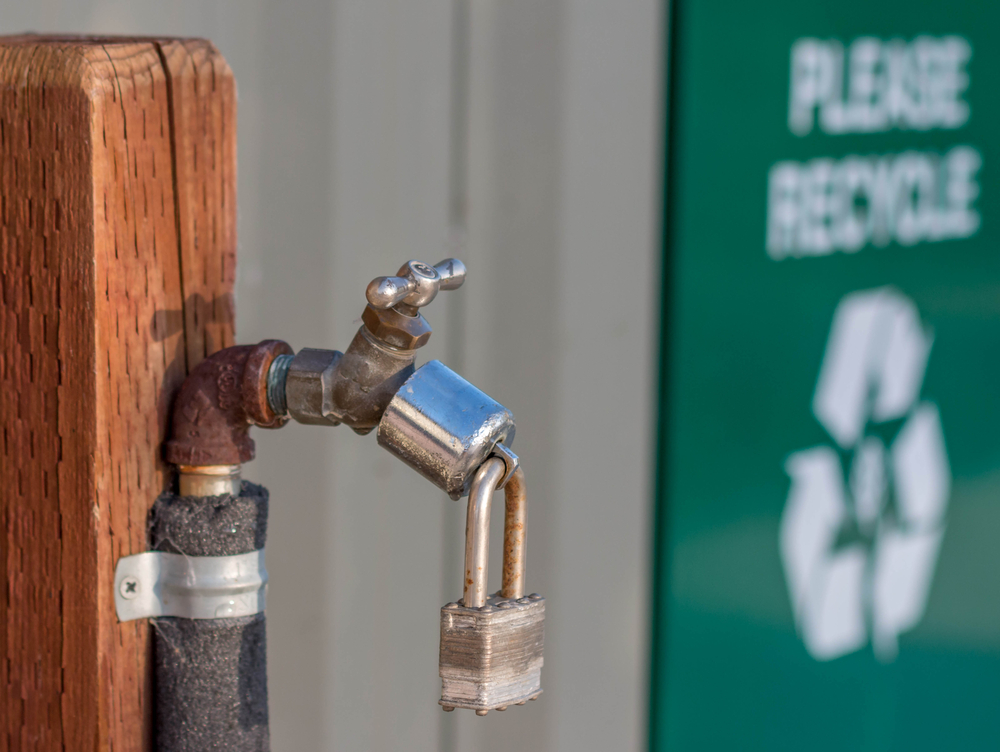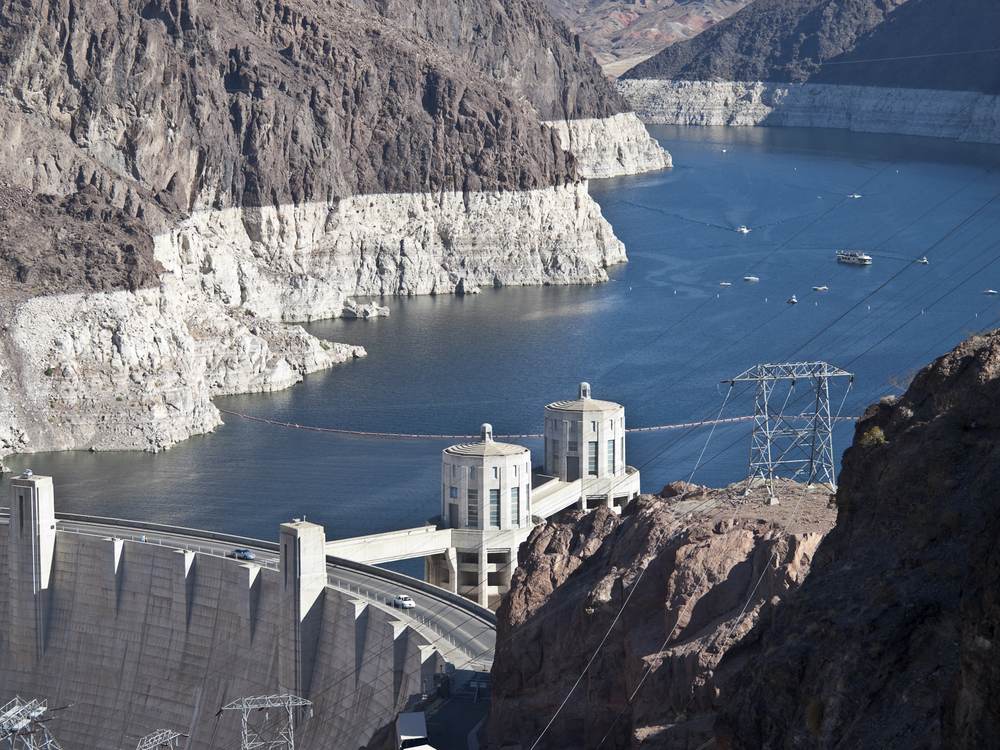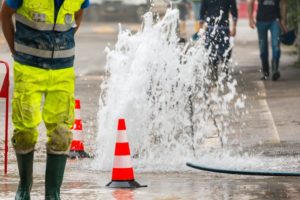California Leaking: People, Pipes, and Prices
By John McKenzie and Richard B. McKenzie


The state’s water problems are threatening, given that more than a hundred reservoirs in the state are well below capacity. Two major reservoirs are at 40 percent capacity, considered to be “critically low” (with the seriousness of the state’s water storage problem made vivid in the above photograph of the Lake Mead reservoir). Moreover, the snowpack in the Sierra Nevada Mountains, a major California water source, is down to a quarter of normal for this time of year.1
The central policy challenge is not whether Californians will reduce their water use for the rest of the year to bring demand in line with the constricted rainfall, but how they will do so—whether by appeals for voluntary conservation, by government fiats to force conservation, or by higher prices to induce less water consumption.
Higher water prices can increase the state’s available water supply—without additional rainfall or the construction of desalination plants. California is annually losing a massive amount of accessed water in its distribution systems largely to known water pipe leaks that are going unrepaired because the added revenue from the sale of recovered water from leak repairs cannot cover the repair costs—at current low water prices. Thus, higher water prices can translate into greater leak repairs and reduced water losses.
The Governor’s Conservation Appeals
California Governor Gavin Newsom is, again, seeking a reduction in annual residential water use, this time up to 30 percent. His first action to solve the state’s water shortage problem has been to appeal to Californians to “Save Our Water.” LA County has recently restricted sprinkling to two times per week. Progressively tighter water use restrictions are likely this summer. The Metropolitan Water District of Southern California has already threatened, if usage doesn’t drop substantially this summer, to eliminate lawn sprinkling by the end of the year.
Appeals for voluntary residential water conservation in the past have had an effect, but a very limited one. Perhaps Californians lack adequate communitarian impulses. No doubt, many don’t care about water conservation (and might never learn of the seriousness of the water shortage) and will balk at calls for a reduction in their water use. More likely, a substantial portion of Californians do care but may do little or nothing to cut usage, following a well-worn line of economic argument (developed by economist Mancur Olsen in the mid-1960s under the banner of the “logic of collective action”2): Each water user can reason (rightfully) that his or her water use is, literally, a drop in a very big bucket of all water used in the state and can conclude that an individual’s conservation efforts will have an inconsequential impact on achieving the state’s restrictive water-use goals.3
Besides, many users have fixed water needs to cover consequential investments in, for example, expensive landscaping. As economists have long recognized, appeals for conservation can work tolerably well in small groups (families, circles of friends, social groups, and churches), because each person’s contribution to the welfare of the whole group is consequential and detectable. However, the effectiveness of the appeals will tend to break down as groups become progressively larger and the effects of individual actions fade.
In groups the size of California’s population, appeals to people’s “better angels” in past droughts have failed to achieve conservation goals without penalties, or threats of penalties, for officially defined “excessive use.” In July 2021 Governor Newsom appealed, because of the drought that year, for a voluntary 15 percent cut in water usage, and Californians across the state collectively reduced their water use by 1.8 percent that month over the year before, according to the California State Water Resources Control Board. Southern Californians reduced total water use by 0.1 percent over what they used in July 2020. People in Los Angeles and San Diego increased their water use by 1 percent over their usage in July 2020 (as estimated by the Los Angeles Times.4)
Without water-price increases, which can give residents a personal economic incentive to conserve, “water police” will likely soon be prowling neighborhoods to enforce restrictions through fines (or the threat of fines) and shaming (a means of imposing personal penalties on those sensitive to others’ opinions).
Water Losses Through Pipe Leaks
The governor and other policy makers continue to overlook a substantial source of additional, largely accessible water buried, literally, under Californians’ feet: water pipe leaks. Authorities overseeing California’s 8,000 water systems are fully aware that a consequential amount of the water entering their systems never reaches consumers’ faucets. Why? California’s distribution systems, consisting of hundreds of thousands of miles of aging pipelines, are full of known leaks that are going unrepaired, mainly because water prices are so low that the revenue from water recovered from fixing them won’t cover the immediate repair or replacement costs.
California water utilities distribute more than 1.2 trillion gallons of water a year to residents (equal to about a fifth of agricultural use), according to government data.5 At least 7 percent of residential accessed water—or at least 84 billion gallons—is lost to known leaks.6 This water volume could, if recovered through repairs, flood more than 191,000 football fields one foot deep—which is enough to meet state government’s targeted annual per person water use of at least 4 million Californians (a tenth of the state’s population). While the critical age and reliability of water pipes varies greatly by water district (as does the rate the consumer is charged), we stress the state’s consolidated estimate of water loss due to leaks is thought to be conservative by some industry insiders. Meaning, we believe there is a high degree of probability that focusing on the economics of water infrastructure repair and replacement could have a consequential offsetting impact to droughts and the need for water police.
We’ve emphasized “at least” because many leaks in the state’s hundreds of thousands of miles of water pipes, if detected, go unreported and others remain undetected but are identifiable with the use of above-ground detection technology. Many water authorities have resisted adopting this technology because leak detection costs (conservatively) about $600 per mile of evaluated pipe, according to the California Water Resources Control Board. To deploy the technology, water authorities must expect the recovered water to generate more revenue than the cost of the repairs or replacement of aging pipes.
Water districts may also be reluctant to find leaks because California law requires districts to report leaks they find and then repair those with water losses greater than “acceptable” loss levels—which means leaks discovered can be budget-busting with below-full-cost water prices. According to the state’s Water Board, the repair cost for service lines averages about $2,300. For a water main break, nearly $6,000—a conservative estimate according to some industry insiders. Of course, the sky is the limit for major breaks, the likes of which are expected to occur progressively as the water system replacement needs go unaddressed.
The Economics of Water-Pipe Leak Repairs

Many leaks go undetected until pipes break and become above-ground geysers that often cause substantial economic damage. In November 2021, a San Diego Uber driver and his passenger were injured by a water geyser from a major pipe failure that took days to repair, causing a shutdown of a section of Interstate 5, resulting in a commuter nightmare, lost earnings for local businesses, and property damage for many residents in the area. The July 2022 break in a twelve-inch water main in the middle of the night in the Hollywood Hills area of Los Angeles caused the shutdown of a major freeway and flooded major streets deep enough to require rescues of drivers from the tops of their cars, as captured on LA nightly news video.7 The repair costs will likely be enormous.
The problem of water pipe breaks and leaks will only worsen in coming years as water pipes continue to age. Two-thirds of LA’s water pipes were installed before 1950 and will reach the end of their useful life this decade. The water main that broke in July in LA’s Hollywood Hills was 91 years old, with many miles of water mains installed more than a century ago. Water officials agree that repairs will cost billions, which cannot be covered without water-price increases.
Again, this means that leak repairs and water recovered depend directly on water prices: The higher the water prices, the more leaks can be detected and repaired—and the greater the potential recovered water. Yet, California water price increases have been checked by Proposition 218, passed in 1996, which places a high burden of proof on all water districts to show that rate increases are necessary and limited to a “cost of service” model (inclusive of the cost of operations, capital improvements, and debt servicing, not necessarily including leak repairs and replacement of pipes well beyond their “life expectancies”).
This legislation is, in part, the cause of surprisingly low water prices in Southern California, given that the area is a “near desert,” meaning the normal rainfall is only modestly greater than the maximum rainfall received by desert areas, 10 inches. The annual rainfall in one author’s home city, Irvine (near the coast, 55 miles south of LAX), is 13 inches, one-third of the country’s average. Yet, he and his neighbors pay only 1 cent a gallon for water for home uses.
Other Californians pay higher prices, but not much more (with prices often graduated with use), excepting isolated areas such as Santa Barbara that operates as a private water district. LA receives less than a third of Atlanta’s rainfall but has residential water rates only 22 percent higher, but that means LA’s rate is higher by only $1.36 ($7.52 versus $6.16) per 100 cubic feet, or only 1 cent per 5 gallons. Los Angelenos can buy 748 gallons of water for less than the price of two lattes at Starbucks. The stark fact is that many people in rain-drenched Louisiana and Mississippi have higher monthly water bills than many higher-income but drought-stricken Californians.
How Higher Water Prices Can Soften the Economic Damage of Droughts
Higher water prices could be a major force in curbing the impact of droughts. They can encourage conservation as Californians more carefully consider their varied water uses—and reduce consumption in big and small ways that fit their preferences (not the preferences of state officials who may force cuts in easily monitored water uses, such as lawn sprinkling). With higher prices, Californians can be expected to reduce or eliminate water uses, with their conservation efforts focused on lower-valued water uses. Accordingly, one household might cut sprinkling while another might minimize shower times.
Higher prices (and the prospects of even higher future prices, if the drought persists) can encourage greater residential adoption of more water-efficient sprinkler systems, appliances, toilets, and landscaping. They can cause water-intense production processes to move to wetter venues.
For more on these topics, see
- “The California Water Crisis: Policing vs. Pricing?,” by Kathryn Shelton and Richard B. McKenzie. Econlib, Sep. 1, 2014.
 David Zetland on Water. EconTalk, March 2015.
David Zetland on Water. EconTalk, March 2015.- Elasticity of Demand. College Topics. Library of Economics and Liberty.
Economists have long known that higher water prices can do the job of increasing water conservation to match shrinking water supply. The most fundamental of economic principles—the Law of Demand, or the inverse relationship between a product’s price and its consumption level—applies, as has been found to be the case in multiple econometric studies. Granted, as research has shown,8 the demand for water in California is highly “inelastic,” which means water use goes down only modestly with a given percentage price increase. However, this “inelasticity” can be extensively chalked up to prevailing extraordinarily low water prices in a near-desert climate. Many Californians don’t have a clue what they pay for water by the gallon or even a hundred cubic feet, because water prices are so low that they need not spend time assessing the price. A vast majority of Californians might not know that a minor water-price increase has been established if they are paying a penny per gallon and the price increase is, say, 20 percent a gallon, which works out to be an unnoticed 0.2 cent increase.
Concluding Comments
Higher water prices can do what the governor and other state officials can’t do: They can raise the revenue-value of recovered water from leak repairs, which can be expected to lead to more repaired pipes. In this regard, higher prices can, effectively, become the equivalent of “rainmakers.” When water becomes scarcer, as happens in droughts, by definition, policy makers have two stark choices: Ration the more limited amount of available water by fiat or by price. The former can do little to boost accessible water. The latter can, in a totally unheralded way.
Footnotes
[1] The Metropolitan Water District of Southern California maintains the state has experienced the driest three years (including a projections for all of 2022) on record and the driest three winter months (January-March) in 2022 on record.
[2] Olson, Mancur, The Logic of Collective Action: Public Goods and the Theory of Groups. Harvard University Press, 1965.
[3] This logic undergirding a likely limited reduction in voluntary water conservation underlies problems of pollution and overfishing in the seas and overgrazing on common-access ranges in the West.
[4] Ian James, “Despite Newsom’s call to cut water use, L.A. and San Diego didn’t conserve in July.” Los Angeles Times, September 21, 2021.
[5] United State Geological Survey, “Estimated Use of Water in the United States County-Level Data for 2015, ScienceBase-Catalog.
[6] With the 7 percent water loss estimated by a sample of 268 water utilities by Kunkel Water Efficiency Consulting, 2018. Report on the Evaluations of 2016 Validated Water Audit Data of California Water Utilities. Philadelphia, Penn.: Kunkel Water Efficiency Consulting, April, p. 7.
[7] “Two Rescued From Roof of Partially Submerged Car After Hollywood Hills Water Main Break”, by Toni Guinyard. NBC Los Angeles, July 20, 2022.
[8] Juneseok Lee and Stephanie A. Tanverakui, “Price elasticity of residential water demand in California.” Aqua, 64, 2015.
*John McKenzie is a former executive at one of North America’s largest water infrastructure manufacturers.
Richard B. McKenzie is the Gerken Professor of Economics and Management Emeritus in the Paul Merage School of Business at the University of California, Irvine. He co-authored with Gordon Tullock The New World of Economics, which went through five editions (and five foreign languages) and was adopted at one time or another in almost all of the country’s colleges and universities in the 1970 and 1980s. The sixth edition was published in 2012.
For more articles by Richard B. McKenzie, see the Archive.
